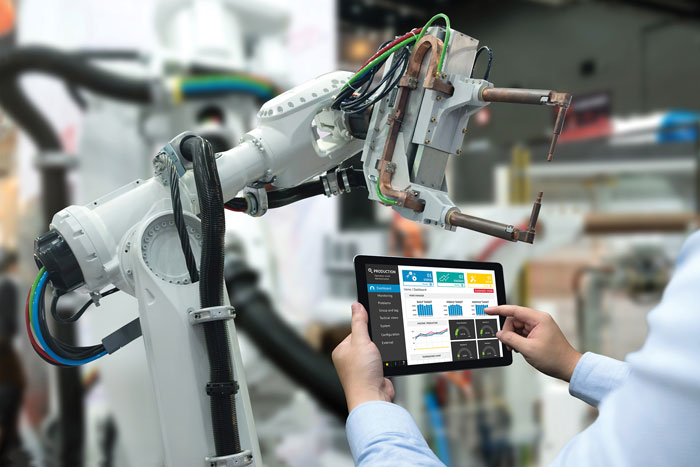
Top industrial automation trends in 2021: Part 2
January 13, 2021
By Manufacturing AUTOMATION
 Photo: Zapp2Photo/Getty
Photo: Zapp2Photo/Getty As the manufacturing sector continues to build itself back up from the disruption caused last year by COVID-19, 2021 promises to be a year of change.
Last week, we shared 10 top trends for industrial automation. Today, we bring you a bonus set of trends from Jim Beretta, host of The Robot Industry podcast and automation industry expert.
See all the trends in the next issue of Manufacturing AUTOMATION, coming to you in early February!—Kristina Urquhart, MA editor
Jim Beretta, The Robot Industry
Jim Beretta, president of Customer Attraction Industrial Marketing based in London, Ont., works with advanced manufacturing, robotics and automation companies. He is also the host of The Robot Industry podcast in partnership with the Robotic Industries Association/A3.
1. The Innovation Decade
Expect to see more money being poured into industrial automation, robotics, software and accessories with the expectation that innovation will come out the other side. Robot companies are releasing new models of robots, and end of arm accessories are becoming innovative, especially in supply chain: point, click and ship.
Young engineers from the University of Waterloo and similar institutions are creating innovative technologies that solve unique, niche problems and they are doing it at the speed of Amazon. Universities, government and even cities are prepared to create environments where these start-up companies can thrive.
Individual companies such as Linamar and Mazak locally are investing in innovation spaces, labs and even entire buildings, understanding that innovation comes at a cost and focused innovation efforts pay off for stakeholders, shareholders and customers.
The robot and automation industry is fairly conservative when it comes to innovation. Baby steps are more common than large leaps. This is understandable as engineers, factories and buyers of automation are loath to take risks that may end careers or, worse, get a poorly working machine named after you.
Take collaborative robots, for example. One of the largest cobot manufacturers in the world just announced that they have sold their 50,000th robot. From nothing to 50,000 units is quite an accomplishment, but it is tiny compared to the total install base of three million robots. The thing that we kind of miss in talking about cobots by themselves is collaboration.
2. The collaboration of safety
One of the interesting trends for 2021 is a new focus on industrial safety. Everything has to have safety baked-in whether it is wireless, wired, safe PLCs or autonomous technology. Where we really see safety shine though is in the design and implementation of collaborative tech: robotics, autonomous material handling bots, such as a new breed of forklifts and autonomous mobile robots (AMRs). Now automation is just working better with people.
We are now witnessing companies producing bolt-on technologies to make all robot applications collaborative, aware and smart.
Elon Musk redesigned one of his Tesla factories when he came to the realization that over-automation – too many robots – just doesn’t work. People are good at thinking, problem solving and anticipation.
I predict that going forward, we will see a renewed interest to make anything that moves in a factory (think smart conveyors) to have safety, plug and play, and collaboration with humans as part of their industrial design. We are now witnessing companies producing bolt-on technologies to make all robot applications collaborative, aware and smart.
3. The app-ification of automation
Industrial automation is hard. Robot programming is extremely difficult. There are fewer and fewer engineers, and fewer robot programmers in factories. We are seeing many different languages and cultures on our factory floors. Connecting and monitoring automation over your cell phone is expected, not just a nice-to-have.
One robot company changed the industry rules when it created its “app store” and later “application kits,” just like Apple’s iStore. You can now buy a cobot with an approved and proven end-of-arm tool and software algorithms pre-built and get it installed and up and working in just hours, allowing you to make money or save money, depending how you look at it. This company offers an easy programming interface and online community of support, just a click away.
The algorithm “set” here is key. Imagine you want to sand wooden furniture using a cobot. Just buy the application kit; it has the sanding patterns included. You just saved weeks in programming and debug. This is our new normal, at the speed of Amazon and as easy to use as your smartphone.
4. The KISS principle
There are a growing number of companies that want to make factories run better and keep it simple. These are well-funded companies, often start-ups, that are accustomed to breaking a lot of rules. They envision simpler operator interfaces, better reporting, increased uptime, mistake proofing, easier decision-making and even programming all robots in a facility with a common language, which is a huge cost and barrier in industrial automation.
Amping up capex and IT budgets with increased monthly investments will be a reality for the next few years, maybe forever.
Software toolkits are getting better and companies that can offer big data solutions to reduce or eliminate unplanned downtime and control spares will just win more work. We are seeing companies disrupting the supply chain by supplying DIY knock-down machine bases or complete conveyor systems. Or even robots delivered in a few days’ or weeks’ time instead of 14 weeks, because they have a better configurator.
Other companies get creative by offering services on a monthly basis: robots-as-a-service. Think automation-as-a-service or machine-vision- or AI-as-a-service.
5. Improving training and knowledge bases
I am suggesting that in 2021, employers will invest in training and knowledge. Our skilled labour shortage is well upon us. For manufacturers, investing in automation is an easy way to attract and retain talent.
After all, who wants to load and unload a machine tool all day long, when one can literally learn to program a robot instead? Manufacturing has changed, with high-mix, low-volume manufacturing being very common, especially here in Canada.
Poka-yoke systems complete with smart screens and dynamic rich content are now affordable and increase manufacturing quality overnight, reducing returns and errors. Bite-sized, daily employee education delivered on cell phones using gamification increases product quality, product safety and engagement, affecting the entire workforce.
There are still challenges ahead. Manufacturers will need to spend more on software going forward. Whether it is artificial intelligence, Internet of Things, Industry 4.0 integration or protecting networks against outside threats, amping up capex and IT budgets with increased monthly investments will be a reality for the next few years, maybe forever.
Investing in STEM, in students and in apprentice or mentorship programs is probably more important now than it has ever been. Fighting for talent is costly, growing your own talent is much better.
Missed part 1 of our industrial automation trends for 2021? Read them here.
Interested to see how 2020’s pre-pandemic predictions stacked up? Read our 2020 insights from ARC Advisory Group, A3, ISA and Interact Analysis.
Advertisement
- Boeing deliveries drop despite 737 Max’s return to flight
- Employers clamp down on ‘ambiguous’ mask rules as more infections tied to workplaces
